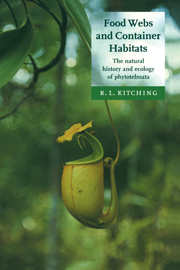Book contents
- Frontmatter
- Contents
- Preface
- 1 Introduction
- Part I The container flora, fauna and environment
- Part II Methods and theories
- Part III Patterns in phytotelm food webs
- Part IV Processes structuring food webs
- 12 Competition and predation – basic forces structuring the community?
- 13 Stochasticism and determinism: processes structuring food webs in phytotelmata
- Part V Synthesis
- Annexe: The phytotelm bestiary
- References
- Index
12 - Competition and predation – basic forces structuring the community?
Population-level structuring processes
Published online by Cambridge University Press: 26 August 2009
- Frontmatter
- Contents
- Preface
- 1 Introduction
- Part I The container flora, fauna and environment
- Part II Methods and theories
- Part III Patterns in phytotelm food webs
- Part IV Processes structuring food webs
- 12 Competition and predation – basic forces structuring the community?
- 13 Stochasticism and determinism: processes structuring food webs in phytotelmata
- Part V Synthesis
- Annexe: The phytotelm bestiary
- References
- Index
Summary
Until relatively recently virtually all theories which attempted to explain the structuring of communities of organisms within ecosystems invoked one of two processes for explanation: competition between species or predation.
Some theory
Competition is conventionally defined as the dynamic process by which two or more species which share similar resources divide up that resource. Accordingly along a particular resource dimension of the habitat in which such species occur we may expect to find that the resource has been subdivided into a series of overlapping fractions by the species utilising that resource. This division is classically considered to be the result of competition or more accurately the avoidance of competition (see, e.g., Whittaker 1975, Whittaker & Levin 1975, Keddy 1989, Strong et al. 1984 and references therein, Putman 1994). Conventional models of community organisation define each species involved in an assemblage of this sort as either being intrinsically better at exploiting a particular segment of a resource dimension or having evolved to do so in order to avoid competition with other species. The resulting segregation and avoidance of competition may be seen in both spatial or temporal terms. In other words visiting a particular habitat at one point in time we may expect to find a set of organisms exploiting different portions of the resource base or we may simply find that a particular resource base is exploited by different organisms at different times during the course of a season or on some other time scale.
- Type
- Chapter
- Information
- Food Webs and Container HabitatsThe Natural History and Ecology of Phytotelmata, pp. 255 - 274Publisher: Cambridge University PressPrint publication year: 2000



